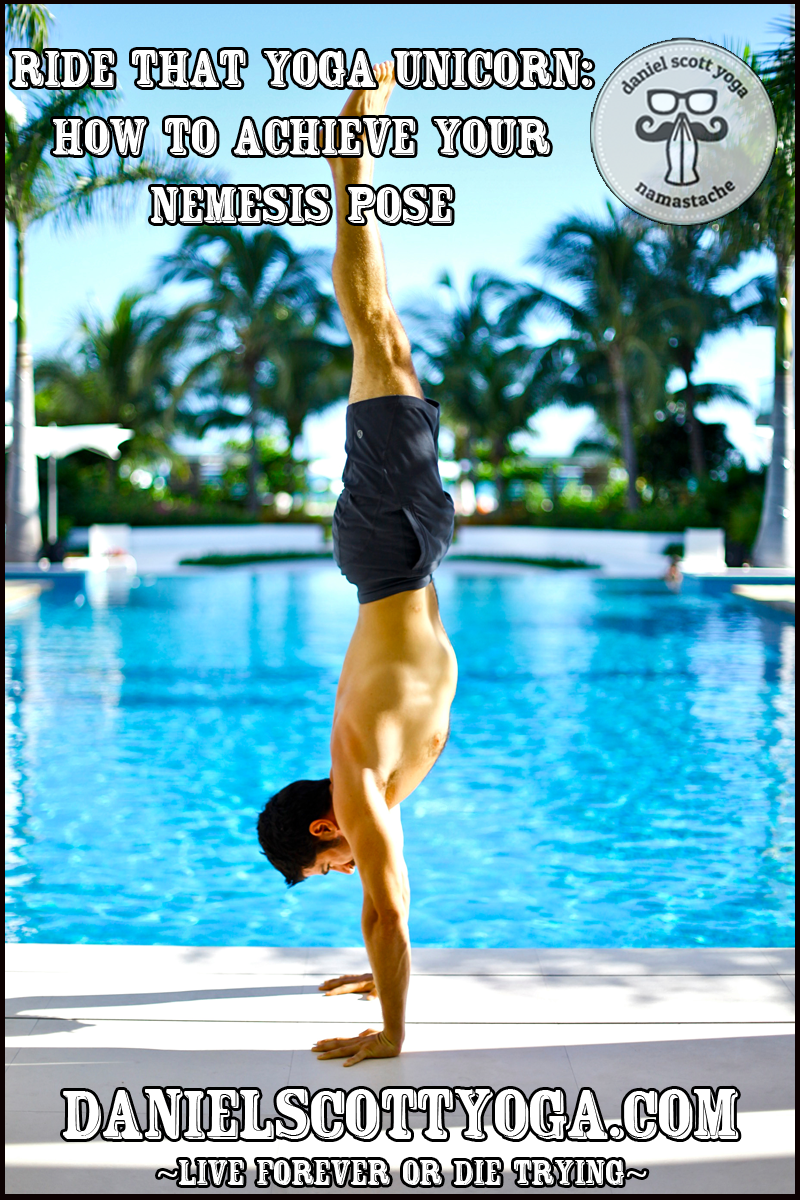

Brian had a sick handstand. Without fail, every Tuesday night, I would leave class thinking the same thing, a thought which would invariably find it’s way into conversations with my friends. ‘That unicorn in the front row– what is his name? Right, Brian. Yeah, Brian has a sick handstand.’
Of course, I knew his name. Everyone did. Unlike so many of us who merely chased unicorns, Brian tamed them. His unicorn farm included an impeccable crow, a fully bound lotus, and even Hanuman split with both hips squared forward. It was as if the teacher taught directly to him, a handmade yoga machine capable of anything.
“That guy is really good at yoga.” I remember thinking about Brian a lot during my first few months of yoga class. He set a standard of awesome I endeavored to match. “I bet I can do that.”
More commonly referred to Nemesis Poses, these are the asanas we love to hate to love due to disagreeing hips, petulant hamstrings, an inflexible back, and a capricious sense of balance. These are the postures that challenge us, existing just outside our range of capability. Some people avoid them like the plague, while others will stop at nothing to master them.
In the beginning, the list of enemies I worked all-too-dillegently to conquer seemingly grew bigger with each class, and my prospects of winning them more distant. Something needed to shift. My ego was taking a beating with nothing to show for it.
And then it hit me. By opting for a more positive approach to the postures I longed to master, my focus shifted from defeating an enemy to befriending my practice. Thus began my fascination with Unicorn Postures.
Things progressed quickly when I stopped doing yoga, and started practicing it. Apparently, yoga unicorns are much easier to attract than to chase. Flash dropped away to replace by substance. Pigeon became comfortable. My knees found armpit-traction in a straight-elbow Crow. I could bind things, and tuck other things behind my head. Sweat didn’t matter. Most importantly, I didn’t care about any one posture because I was grateful for all of them.
Years later, a common theme has been woven into both my personal practice and the one I share as a teacher: There is no competition in yoga. This is something I truly believe, and most days, I remember it a good 81 percent of the time. Maybe 82. It’s a work in progress.
It’s probably safer to say that despite the fact there is a huge amount of competition in yoga studios, there is no need for competition in yoga. As practitioners, we either take it or leave it. If ultimately we do choose to partake in competition, it then becomes our responsibility to govern where it takes us.
Why do we chase unicorns? We see them from afar, gracing the covers of yoga magazines, dancing across countless internet websites, and– if we’re lucky– just a few yoga mats away in class. They represent expertise and mystique, dedication and depth. Let’s also not forget how pretty they look, and who doesn’t want to look pretty?
No matter the reason, here are are a few important tips to remember when chasing unicorns.
1. There is no competition in yoga. Unicorns are care-free creatures who hate competition. There is a reason it’s called a “yoga practice” and not a “yoga perfect.” You won’t win a medal for having the best handstand– unless, of course, you’ve actually entered yourself into a yoga tournament. Even so…
2. Do “YOUR” best instead of being “THE” best. To thine own unicorn be true. Every body is different. Certain people are blessed with an innate flexibility or strength that you don’t posses. Others come from a background of dance, gymnastics, or [insert sport here] as a solid foundation for their physical practice of yoga. Don’t try to brazenly compete, just aim to happily complete.
3. Identify a Clear Goal. Unicorns respond well to simple, yet effective goals. While “a sick handstand” sounds great when first starting out, be completely open about what you want while being realistic of your current experience. Once you decide to “hold a fearless handstand in the middle of the room for 30 seconds”, you will be able to…
4. Break down the necessary steps to achieve. It’s easier to catch a large unicorn if you start small and work your way up. Visvamitrasana, for example, requires open hips, hamstrings, and shoulders balanced with strong hands and feet. Outline the dots you need to connect in order to unlock the big picture. Find mastery in Trikonasana (Triangle), Parsvakonasana (Side Angle), Vashistasana (Gate), Parivrtta Surya Yantrasana (Compass). Throw in a couple Bhaddaa (binds) or two into the process for good measure, making sure to remember one thing:
5. Don’t think about how it looks, care about how it feels. Unicorns love having fun. Remember this as you enjoy your yoga. If your practice consists of force, injury, and judgement, ask yourself this: Why? I personally enjoy practicing with people who show UP, not show OFF. The more you enjoy your practice, the more it serves you. By building a strong foundation of self-care and appreciation, you’ll diligently expand your unicorn farm to include new postures over time.
6. If at first you don’t succeed, TAKE A BREAK and try, try again. It’s totally cool to work hard. Really, one should not be afraid to put work into their practice through dedication and experience. However, it’s also extremely important to know when to say when. Drop into child’s pose, wipe your face down, take a sip of water, breathe deeply, sigh loudly, laugh openly. Unicorns can be flighty creatures that are often here today, gone tomorrow. That being said…
7. Constantly refine. If the only tool you have is a hammer, all of your obstacles start looking like nails. This is not helpful when working with such delicate creatures as unicorns. It’s ok to take a few steps back from the edge in order to fully appreciate the ground you already walk on. That fearless 30 second handstand might be a few years away, but a solid one against a wall with straight arms and strong fingers might be just around the corner. Which bring us to one final thought…
8. Time matters not. You have your whole life to catch unicorns. There is no finish line in yoga. Your goals change as you do. If you’re truly meant to have a sick handstand, it will happen because you made it happen, not because you set a trap, waved a magic wand, or caught a mythical creature. While I haven’t seen Brian in years, I silently offer thanks to him every time I practice in honor of the unicorns he helped me to enjoy.
–Originally posted on MindBodyGreen.com (link HERE)–
© Daniel Scott Yoga | All rights reserved
Design by NXNW.
Octavio
June 11, 2013 at 11:31 pmThanks for writing this Daniel! Such good advice (for me especially)!!!
tracy
June 14, 2013 at 10:00 pmI think there could be a unicorn hiding in my garage….maybe one day I’ll see it. 🙂
Ambika Devi
July 23, 2013 at 10:42 amDo the Unicorns sit still in meditation?
Daniel Scott
July 25, 2013 at 5:24 amUnicorns have to deal with the same amount of distraction and challenge that we do during meditation. The biggest difference is that unicorns fart rainbows. That’s about it.
Lou Segura
March 3, 2014 at 10:07 amUnicorns come in so many shapes colors and sizes. Catch them all, all that you can! Namste
Daniel Scott
March 15, 2014 at 7:23 pmAgreed.